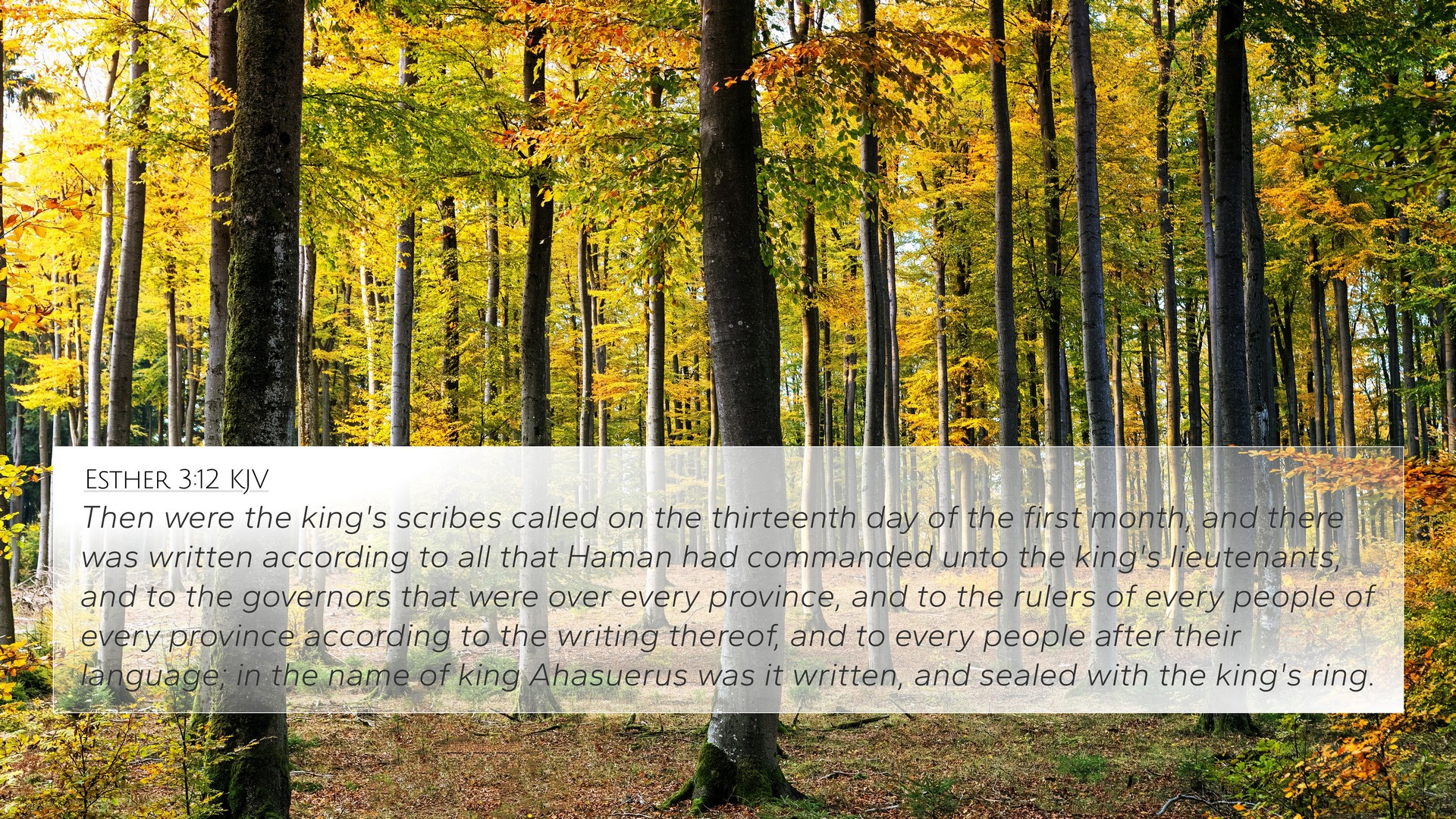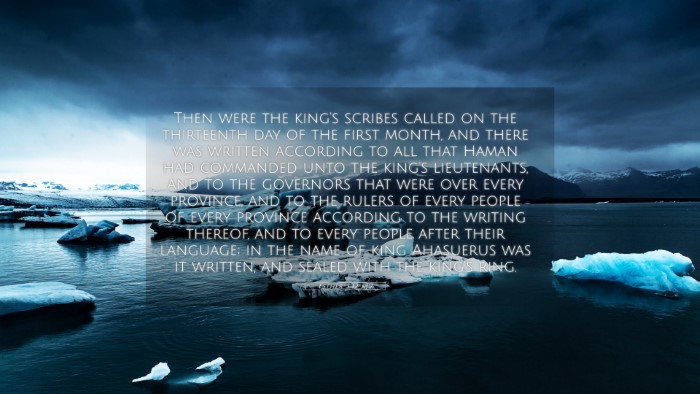Old Testament
Genesis Exodus Leviticus Numbers Deuteronomy Joshua Judges Ruth 1 Samuel 2 Samuel 1 Kings 2 Kings 1 Chronicles 2 Chronicles Ezra Nehemiah Esther Job Psalms Proverbs Ecclesiastes Song of Solomon Isaiah Jeremiah Lamentations Ezekiel Daniel Hosea Joel Amos Obadiah Jonah Micah Nahum Habakkuk Zephaniah Haggai Zechariah MalachiEsther 3:12 Similar Verses
Esther 3:12 Cross References
Then were the king's scribes called on the thirteenth day of the first month, and there was written according to all that Haman had commanded unto the king's lieutenants, and to the governors that were over every province, and to the rulers of every people of every province according to the writing thereof, and to every people after their language; in the name of king Ahasuerus was it written, and sealed with the king's ring.
Uncover the Rich Themes and Topics of This Bible Verse
Listed below are the Bible themes associated with Esther 3:12. We invite you to explore each theme to gain deeper insights into the Scriptures.
Esther 3:12 Cross Reference Verses
This section features a detailed cross-reference designed to enrich your understanding of the Scriptures. Below, you will find carefully selected verses that echo the themes and teachings related to Esther 3:12 KJV. Click on any image to explore detailed analyses of related Bible verses and uncover deeper theological insights.
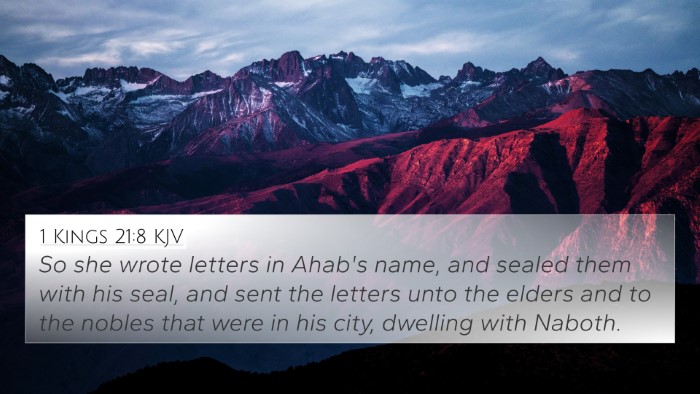
1 Kings 21:8 (KJV) »
So she wrote letters in Ahab's name, and sealed them with his seal, and sent the letters unto the elders and to the nobles that were in his city, dwelling with Naboth.
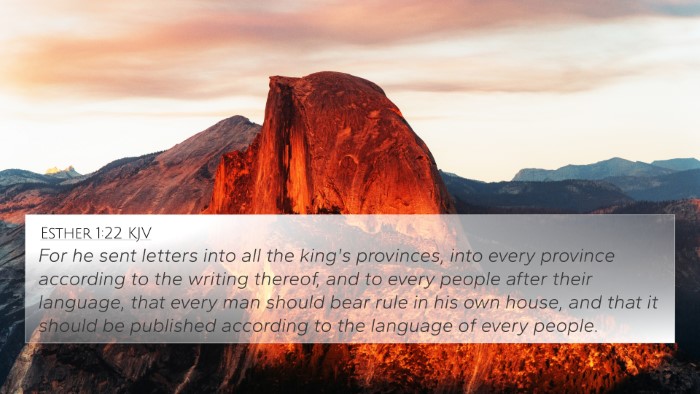
Esther 1:22 (KJV) »
For he sent letters into all the king's provinces, into every province according to the writing thereof, and to every people after their language, that every man should bear rule in his own house, and that it should be published according to the language of every people.

Ezra 8:36 (KJV) »
And they delivered the king's commissions unto the king's lieutenants, and to the governors on this side the river: and they furthered the people, and the house of God.
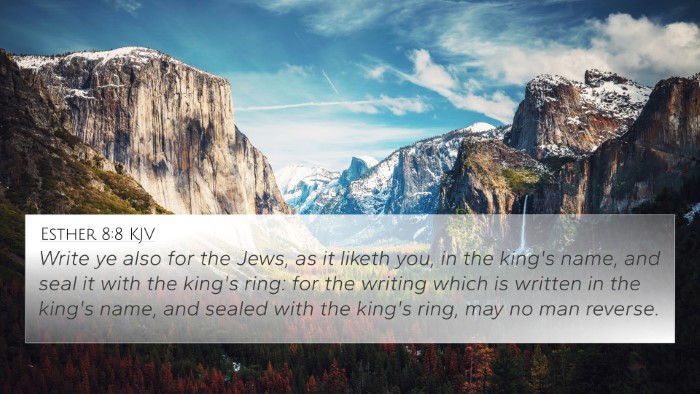
Esther 8:8 (KJV) »
Write ye also for the Jews, as it liketh you, in the king's name, and seal it with the king's ring: for the writing which is written in the king's name, and sealed with the king's ring, may no man reverse.

Esther 9:27 (KJV) »
The Jews ordained, and took upon them, and upon their seed, and upon all such as joined themselves unto them, so as it should not fail, that they would keep these two days according to their writing, and according to their appointed time every year;
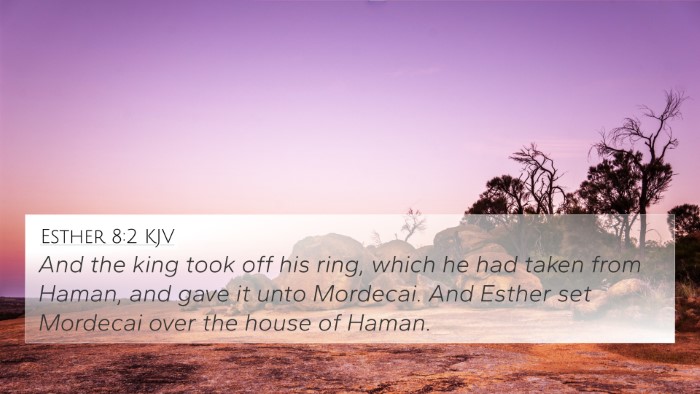
Esther 8:2 (KJV) »
And the king took off his ring, which he had taken from Haman, and gave it unto Mordecai. And Esther set Mordecai over the house of Haman.
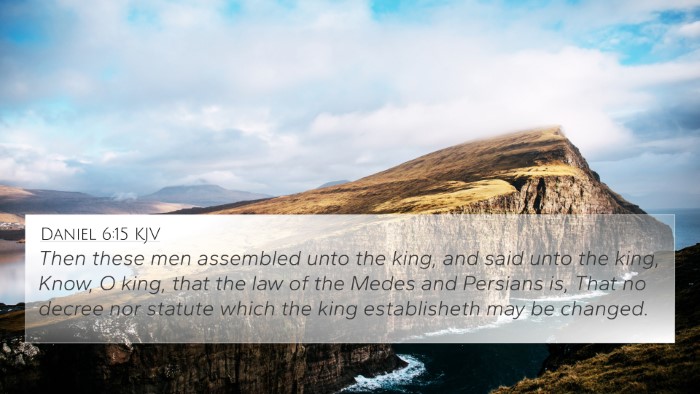
Daniel 6:15 (KJV) »
Then these men assembled unto the king, and said unto the king, Know, O king, that the law of the Medes and Persians is, That no decree nor statute which the king establisheth may be changed.
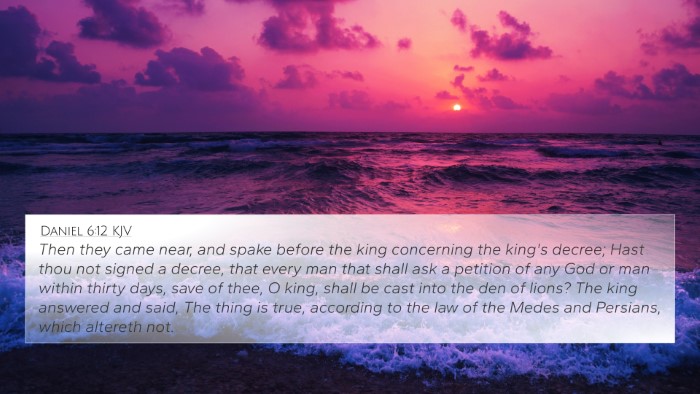
Daniel 6:12 (KJV) »
Then they came near, and spake before the king concerning the king's decree; Hast thou not signed a decree, that every man that shall ask a petition of any God or man within thirty days, save of thee, O king, shall be cast into the den of lions? The king answered and said, The thing is true, according to the law of the Medes and Persians, which altereth not.
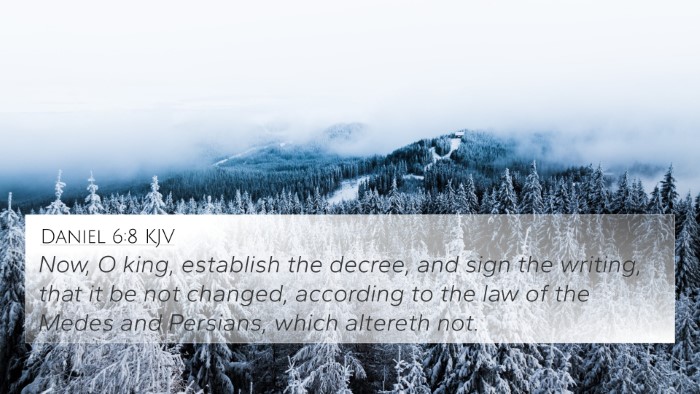
Daniel 6:8 (KJV) »
Now, O king, establish the decree, and sign the writing, that it be not changed, according to the law of the Medes and Persians, which altereth not.
Esther 3:12 Verse Analysis and Similar Verses
Understanding Esther 3:12
Esther 3:12 presents a pivotal moment in the narrative of the Book of Esther, wherein the plots against the Jewish people begin to unfold. In this verse, King Ahasuerus (Xerxes) gives commands to orchestrate a decree to annihilate the Jews, illustrating the theme of persecution and the dangers facing the chosen people of God.
Contextual Insights
This verse is set within the context of Haman's insidious plot against the Jews, motivated by personal animosity towards Mordecai, who refused to show him honor. The events described are crucial to understanding the narrative arc and the internal and external conflicts faced by the Jewish people in the Persian Empire.
Commentary Summaries
Matthew Henry states that this decree was “fueled by the great enmity and malice of Haman against the Jews.” He underscores the ominous nature of the king’s authority being manipulated by Haman, emphasizing the vulnerability of the Jewish people and their impending crisis.
Albert Barnes elaborates that Haman's plot was not only an attack on the Jews but also a challenge to the divine plan and protection over God’s chosen people. He notes that the decree represents a broader theme of gentile hostility towards the Jews as seen throughout Biblical history.
Adam Clarke highlights the administrative details of the decree, emphasizing the systematic approach Haman employed in his plot. Clarke also points out the impact of such state-sponsored persecution, reflecting on the historical implications for the Jewish exiles and their identity amidst oppression.
Bible Verse Cross-References
Esther 3:12 can be interlinked with several other verses that reflect similar themes of persecution and divine protection:
- Psalm 37:1-2 - “Do not fret because of evildoers…” - conveys the reassurance of God’s justice amidst the plot against the righteous.
- Jeremiah 51:24 - “And I will repay Babylon and all the inhabitants of Chaldea…” - reflects God's judgment against those who oppose His people.
- Esther 4:14 - “For if you remain completely silent at this time…” - shows the providential role that Esther will play in the salvation of her people.
- Exodus 14:14 - “The Lord will fight for you…” - emphasizes the theme of divine deliverance in times of crisis.
- Isaiah 54:17 - “No weapon formed against you shall prosper…” - a reminder of God’s protection over His people.
- Proverbs 21:1 - “The king’s heart is in the hand of the Lord…” - highlights God's sovereignty over rulers and decisions.
- Ephesians 6:12 - “For we do not wrestle against flesh and blood…” - a New Testament reflection on spiritual conflict.
Thematic Connections
The verse embodies themes of divine sovereignty, persecution, and intervention. These themes are recurrent across both the Old and New Testaments, forming an inter-biblical dialogue about God’s faithfulness to His covenant and the trials His people face.
The events in Esther demonstrate the connection between human agency (Haman’s plot) and divine purpose (God’s overarching plan for His people), showcasing the intricacies of faith during tumultuous times.
Tools for Bible Cross-Referencing
Studying Esther 3:12 in conjunction with other scripture can be enhanced through various resources:
- Bible Concordance - To find related themes and verses quickly.
- Bible Cross-Reference Guide - Useful for thematic studies.
- Comprehensive Bible Cross-Reference Materials - Tools designed for deeper analysis and understanding.
- Cross-Reference Bible Study - Methods to facilitate group discussions on interrelated texts.
How Cross-Referencing Helps
Understanding Esther 3:12 through cross-references provides a fuller theological context:
- It allows readers to see the continuity of God’s narrative across scriptures.
- Facilitates a deeper understanding of how themes of deliverance are woven throughout the Bible.
- Enhances personal study and sermon preparation through an analysis of scriptural parallels.
Conclusion
Esther 3:12 stands as a significant verse within the narrative, showing both direct implications for the Jewish people and a broader theme of God’s protective hand over His chosen. By cross-referencing this verse with others, we deepen our understanding of the challenges faced by the faithful and the assurance that God's purposes will prevail.
